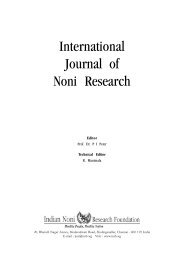International Journal of Noni Research - Noni Family
International Journal of Noni Research - Noni Family
International Journal of Noni Research - Noni Family
You also want an ePaper? Increase the reach of your titles
YUMPU automatically turns print PDFs into web optimized ePapers that Google loves.
D.R.Singh et al. Peptide and Mineral pr<strong>of</strong>ile <strong>of</strong> Morinda citrifolia fruits and leaves<br />
Morinda citrifolia, commonly known as noni, is a shrub or small tree belongs<br />
to a family Rubiaceae, is a native to Southeast Asia and Australia but has been<br />
extensively spread by man throughout India and into the Pacific islands. In<br />
Andaman & Nicoabri islands, it is commonly known as Lovany, Burmaphal,<br />
Pongee phal and Surangi by the tribals ( Singh et. el., 2005).<br />
Over the last decade, a growing number <strong>of</strong> people have become interested in<br />
the medicinal uses <strong>of</strong> noni juice, made from the fruit <strong>of</strong> the Indian mulberry<br />
(Morinda citrifolia) <strong>of</strong> the South Pacific Islands <strong>of</strong> Tahiti, and more recently<br />
from Hawaii. Morinda citrifolia has been used in folk remedies by Polynesians<br />
for over 2000 years, and is reported to have a broad range <strong>of</strong> therapeutic<br />
effects, including antibacterial, antiviral, antifungal, antitumor, antihelminthic,<br />
analgesic, hypotensive, anti-inflammatory, and immune enhancing effects (Singh<br />
et.al., 1984, Whistler, 1985). It has attained significant economic importance<br />
worldwide in recent years through a variety <strong>of</strong> health and cosmetic products<br />
made from leaves and fruits. These include fruit juice as well as powders made<br />
from the fruit or leaves. However, scientific evidence or the research findings<br />
are limited.The history <strong>of</strong> published medical research on noni phytochemicals<br />
numbers only around a total <strong>of</strong> 120 reports which began appearing in the<br />
1950s. Just since 2000, about 105 publications on noni have been published<br />
in medical literature, defining a relatively young research field. Nearly all noni<br />
research is at a preliminary stage, still in the laboratory as in vitro or basic<br />
animal experiments. Despite the large market for juice products and research<br />
developments, the nutrient and phytochemical pr<strong>of</strong>iles <strong>of</strong> noni have not been<br />
extensively studied.<br />
Morinda citrifolia has been documented to contain a mixture <strong>of</strong><br />
anthraquinones, organic acids, xeronine, several vitamins (such as beta-carotene,<br />
niacin, rib<strong>of</strong>lavin, thiamine), some minerals, iron and calcium (Duke, 1992,<br />
Levand & Larson , 1979, Moorthy & Reddy, 1970).The potassium content is<br />
similar to that in tomato juice and orange juice. Some <strong>of</strong> the beneficial<br />
constituents <strong>of</strong> <strong>Noni</strong> include various terpene compounds, caproic and caprylic<br />
acids, vitamin C and alkaloids. However, <strong>Noni</strong> is most famous for the presence<br />
<strong>of</strong> an alkaloid proxeronine, which is believed to be a precursor to xeronine<br />
(Heinicke, 1985).<br />
In order to obtain better understanding <strong>of</strong> the medicinal characteristics <strong>of</strong> the<br />
noni fruits and leaves, the biochemical pr<strong>of</strong>ile and the mineral compositions<br />
<strong>of</strong> the fruits and leaves <strong>of</strong> the M.citrifolia is very important. The present study<br />
was conducted to study the biochemical pr<strong>of</strong>ile and the mineral pr<strong>of</strong>ile <strong>of</strong> the<br />
fruit and leaf <strong>of</strong> M. citrifolia plants present in different locality <strong>of</strong> these islands.<br />
The extent and pattern <strong>of</strong> mineral deficiencies/imbalances in plants vary in<br />
different agro-climatic condition as available mineral content in the green<br />
Intl. J. <strong>Noni</strong> Res. 2007, 2(1-2) 76








